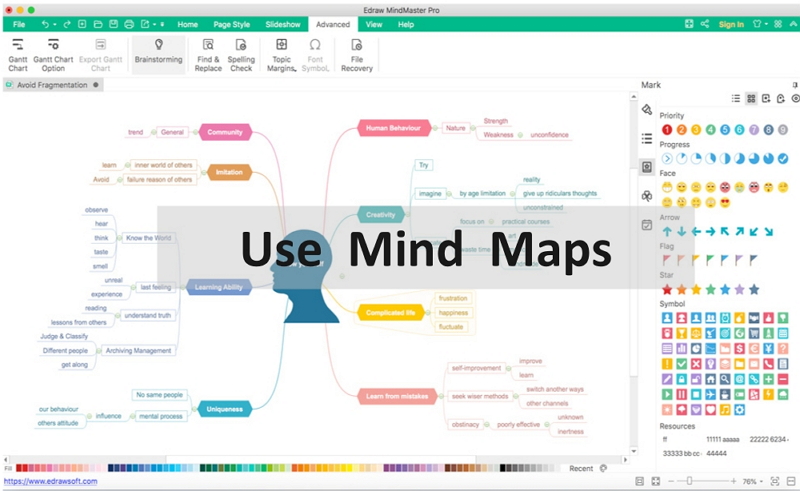Studying can be a daunting task for many students, especially when it involves large amounts of information. With the rise of modern education techniques, students are now exploring methods that not only enhance learning but also make the process more engaging and effective. One such technique is mind mapping, which has proven to be an invaluable tool for smarter studying. But what exactly is mind mapping, and how can it improve your study routine? This article delves into the concept of mind mapping, its benefits, and how it can help students study smarter and more efficiently.
What is Mind Mapping?
A mind map is a visual representation of ideas and concepts that are connected around a central theme. It allows you to organize information in a non-linear fashion, making it easier to understand and recall. Unlike traditional note-taking, which involves writing down ideas in a linear format, mind mapping encourages creative thinking by branching out ideas from a central core. This method of organizing thoughts has been widely used in education, business, and personal development because it helps structure complex information in a way that is both intuitive and easy to follow.
How Does Mind Mapping Work?
The process of creating a mind map starts with a central idea placed at the center of the page. This could be a subject you’re studying, a problem you need to solve, or a concept you want to explore. From the central idea, you draw branches that represent major categories or subtopics related to that idea. Each branch can further split into smaller sub-branches that detail more specific concepts or facts. By linking ideas visually, mind maps enable you to see the relationships between various pieces of information, making them more memorable and easier to recall during exams or assignments.
The use of colors, images, and keywords further enhances the visual appeal of mind maps, which can help in memory retention. The brain tends to remember visual stimuli better than plain text, which is why mind maps can be a powerful tool for students.
Benefits of Mind Mapping for Smarter Studying
Mind mapping offers several benefits that can significantly improve your study sessions. Here are some of the main advantages:
1. Enhanced Memory Retention
Studies have shown that mind maps improve memory retention by up to 20%. The visual format helps create more neural connections, making it easier for the brain to store and retrieve information. By associating information with colors, shapes, and images, your brain is better equipped to remember concepts long-term.
2. Better Organization of Information
Mind maps allow you to organize information logically, which can help you understand complex topics more easily. Rather than sifting through pages of linear notes, you can see the relationships between different pieces of information in a snapshot. This structured approach enables you to identify key themes, relationships, and hierarchies within the material, making it easier to tackle.
3. Increased Creativity
Mind mapping is a creative process that encourages thinking outside the box. It helps break away from the rigid structure of traditional note-taking by allowing you to explore different ways of organizing information. This flexibility can lead to more innovative ideas, especially when brainstorming or solving complex problems.
4. Efficient Study Sessions
Mind maps help students focus on the most important points of a topic, which leads to more efficient study sessions. By creating a mind map, you can quickly identify key ideas and concepts, cutting down on the time spent reviewing irrelevant material. This approach also helps you stay focused, as it visually guides you through the study material step by step.
5. Improved Understanding of Complex Subjects
When dealing with complex subjects, it can be difficult to keep track of all the details. Mind mapping breaks down information into digestible chunks, helping you grasp complicated concepts. This method is especially useful in subjects that require you to understand how different elements are connected, such as history, science, and literature.
How to Create a Mind Map for Studying
Creating a mind map is simple, and you don’t need any special tools to get started. All you need is a blank sheet of paper, a pen, and some creativity. Here’s a step-by-step guide on how to create a mind map for studying:
Step 1: Start with a Central Idea
At the center of your page, write down the main topic or subject you’re studying. This could be a chapter title, a key concept, or even a question you want to explore.
Step 2: Add Major Categories or Subtopics
Draw branches from the central idea, each representing a major category or subtopic related to the main theme. For example, if you’re studying biology, your main branches might include topics like “Cell Biology,” “Genetics,” and “Ecology.”
Step 3: Expand with Detailed Information
From each major branch, draw smaller branches to add specific details or facts related to that subtopic. These could include definitions, theories, formulas, or examples. The goal is to break down complex information into manageable parts.
Step 4: Use Keywords, Colors, and Images
Use keywords to keep your mind map concise and easy to follow. Colors can be used to differentiate between branches, highlight key points, or indicate the importance of certain concepts. You can also draw simple images or symbols to further illustrate ideas and make the mind map visually appealing.
Step 5: Review and Revise
Once your mind map is complete, take some time to review it. Does it make sense? Are there any areas that need further clarification or expansion? Reorganizing your mind map can help you refine your understanding and ensure that you have all the relevant information at your fingertips.
Mind Mapping Tools for Digital Study
While paper-based mind maps are effective, there are also several digital tools that can help you create more polished and interactive mind maps. These tools often include features like drag-and-drop, cloud syncing, and collaboration options, making them ideal for group projects or for students who prefer working digitally. Some popular digital mind mapping tools include:
-
MindMeister: A user-friendly online mind mapping tool that allows you to create, share, and collaborate on mind maps in real time.
-
XMind: A robust mind mapping software that offers various templates and customization options for creating detailed maps.
-
Coggle: A simple and intuitive tool that lets you create collaborative mind maps with ease.
Conclusion
Mind mapping is an effective and powerful tool for smarter studying. Whether you’re looking to enhance memory retention, better organize information, or simply make studying more fun, mind maps can provide the visual structure that traditional study methods lack. By adopting this technique, students can unlock new levels of understanding and creativity, leading to improved academic performance. So, the next time you sit down to study, consider using mind maps to organize your thoughts and study more efficiently.





